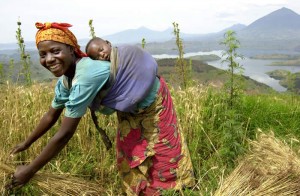By Denise Lionetti, IYCN Project Director
I saw the effects of the global food crisis during my recent trip to Kenya, where a prolonged drought coupled with high food prices have left significant numbers of Kenyans vulnerable to hunger and malnutrition. High food prices have continued to reduce access to food for significant numbers of people in poor countries.
As new global food security policies take shape to help Kenya and other countries cope with future shocks and food price increases, the global community needs to take a comprehensive approach to addressing hunger and food security—and nutrition programs should be part of any strategy. It is critical for policies and programs that aim to improve access to food go hand-in-hand with efforts to improve the quality of available food and promote better nutrition practices—especially for mothers and children two years old and younger.
The need for prioritizing good nutrition is clear: just because families have food does not mean that they are getting the nutrients they need to keep them healthy. We, in the global health community, have seen this reality through our work in many different country situations. In Kenya, malnutrition persists among children even in the country’s food secure Western Province. Although access to food has not been considered a problem compared with other areas in the country, a recent assessment conducted by the IYCN Project revealed that many kids do not get the right kinds of foods frequently enough to ensure good nutrition—leaving them vulnerable to malnutrition and more prone to illnesses. In order to effectively reduce hunger and malnutrition, food security programs should include proven, low-cost nutrition interventions such as counseling to improve infant feeding practices.
In the US, many non-governmental organizations and policy makers agree that nutrition should be an important part of an integrated food security strategy. In February 2009, more than 40 relief and development organizations launched a report, A Roadmap for US Leadership to End Global Hunger recommending a comprehensive strategy to promote global food security. It specifically outlines that a food security strategy should include emergency response, nutrition, safety nets and agriculture development. Influenced by this report and advocacy efforts by the NGO community, bills have been introduced in Congress that address the fight against hunger and include nutrition as an important component.
It is encouraging that the Obama administration’s new food security initiative appears to address the need for a comprehensive approach to fighting hunger. On September 26, Secretary Clinton unveiled the plan by outlining five pillars—the first is to comprehensively address the underlying causes of hunger and undernutrition. In advance of the announcement, USAID issued a new fact sheet further explaining the role of nutrition in the administration’s food security initiative: “A comprehensive food security strategy integrates nutrition, and improving maternal and child nutrition should be a key measure of success.”
Over the coming months, US policy makers will move forward with commitments. Policy makers are also discussing food security in developing countries. I encourage all of our nutrition colleagues to actively join the discussions to make sure that nutrition is addressed along side improvement of agriculture development and climate change. In addition, agriculture development should address food and nutrition security at household levels recognizing that women must be included. Women are the primary workers on small holder farms and they, along with young children, are most vulnerable to poor nutrition. Engage your colleagues in the ministries of agriculture, finance and planning and donors to emphasize the critical role of nutrition.
We must continue to ensure that efforts to improve nutrition—especially during the first two years of life—are more fully incorporated and emphasized in all of our anti-hunger and food security programs. Now is the time to participate in these discussions to help ensure that that we effectively reduce the hunger and malnutrition that contributes so substantially to infant and child morbidity and mortality in the developing world.
Send us your comments. Tell us about your thoughts on this article by sending an email to info@iycn.org. We will post selected comments on this page.
Read A Roadmap for US Leadership to End Global Hunger.
Learn more about IYCN activities in Kenya.
Photos: Aurelio Ayala III, PATH/Carib Nelson, WFP/ Tom Haskell, Oluseyi Akintola
Date: Sep 6, 2009 | Category: Points of view

